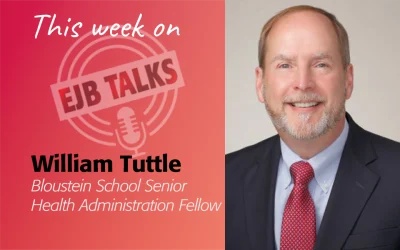This week on EJBTalks, Stuart Shapiro welcomes a new professor from the school’s undergraduate public health program, Derek DeLia. Professor DeLia explains how he became interested in the field of health economics and talks about his 25-year career in health policy and health services research. He also shares details about his recent research regarding limb salvage versus limb amputation and the clinical solutions which vary along racial, ethnic, and economic lines. Stuart and Derek conclude with a discussion on how access to better medical care, better patient care, and better treatment options are possible through medical treatment incentives.
Stuart Shapiro
Welcome to EJB Talks. I’m Stuart Shapiro, the Interim Dean of the Bloustein School, and the purpose of this podcast is to highlight the work my colleagues and our alumni in the fields of policy, planning, and health are doing to make the world a better place.
We’re spending this, our eighth season of the podcast, speaking with our new faculty at Bloustein. We hired 10 in a wide array of fields as this season will show. Today, we are talking to one of our new professors in our public health program, Professor Derek DeLia. Welcome to the podcast Derek.
Derek DeLia
Thank you, Stuart. It’s great to be here.
Stuart Shapiro
So I like to start with the origin story almost always. So, you’re a health economist, someone after my own heart there. Why did you get into health economics? What led you there?
Derek DeLia
Sure, sure. Well, you know, as a kid, I always liked subjects like math and social studies, and always wondered, how can you put the two together, you know, analyze social phenomena, but from a more, analytic mathematical perspective. And then went to college, thought about being a civil engineer for a while, but took an economics class and thought, “Wow, this, this looks like something that I’m really interested in.” Wound up majoring in economics and mathematics and had a professor named Jack Worrall at Rutgers-Camden, where I got my undergrad degree, who kind of nudged me and said, “You know, a Ph.D. in economics is pretty cool. It looks like you might be interested”. And I thought yes. The more I learned about it, the more I saw this would be a great way to spend my time.
And, you know, back when I was finishing school, it was back when there was this debate about health care. There was a presidential election and Bill Clinton ran for president and when he became president, tried to do something big with health care, and found it very difficult. And in the course of that debate, I thought, you know, there are a lot of important issues here that we need to resolve. And I don’t think they’re going to be resolved with just, one law and, that’s it, we’re done. I think there’s a lot to do here, and I’m glad I have been involved with health policy and health services research now for about 25 years.
Stuart Shapiro
And 15 years later, we finally did get healthcare reform.
Derek DeLia
We did but didn’t quite solve all the problems…
Stuart Shapiro
That’s for sure.
Derek DeLia
But put a framework in that can solve problems. I think that is the biggest thing about the Affordable Care Act is there’s a solid framework that you can build off of it. And, you know, we have been building, you know, spin-offs from the Affordable Care Act ever since it was passed.
Stuart Shapiro
The Biden administration has certainly been emphasizing sorts of expansions and new interpretations of the Act, which I think have been very helpful.
Derek DeLia
Yeah, I think so. And like I said, the framework is there, you don’t have to create it from scratch, it’s more, take a branch of it and you know, add to it, expand subsidies, and eligibility, and so on.
Stuart Shapiro
So a lot of your recent work has been about patients who have lost a limb, which is interesting, feels a little bit like a niche, but as we’ll talk about has much bigger implications. But I did want to sort of ask what led you here and why it’s been a useful area to draw broader conclusions about the healthcare system.
Derek DeLia
Sure, sure. So I got interested in it really because I had some colleagues at MedStar Georgetown University Hospital. Some surgeons who were doing work in this area, and in conversations with them, I found, you know, this is an area that seems to be…. really actually two things very important for patients and also really untouched by the world of health economics and health policy. So from the patient perspective, losing a limb is really a serious thing. And it happens with advanced stage, diabetes, peripheral vascular disease, you get to the point where the limb has become so damaged that you know, it gets cut below the knee or the below the foot. And you know, when this happens, you’ll keep the person alive, which is great, but not for very long, five-year mortality rates are very high.
When people have an amputation, their quality of life goes down. There’s a real emotional component to this as well. You know, losing a limb is something that really hits people hard emotionally and it leads to depression and poor self-care and other things like that. So I felt it was an important, really public health issue. Because there are ways to prevent this, there are surgical techniques. When you have advanced peripheral vascular disease, you can prevent the limb from being amputated. There are limb salvage procedures. But I wondered who has access to these. And what does the market look like?
You know, economists often study different diseases, and different procedures, there’s a lot of economics research on cardiovascular disease and orthopedic surgery and things like that. There’s very little that’s been done in the broader world of plastic and reconstructive surgery. As one colleague told me, it’s sort of the wild west out there. We don’t do pay for performance, we don’t do Value-Based Payment the way we see in other fields. And so it just seemed wide open from a policy and economics perspective. We need to get under the hood and look at what’s going on here.
Stuart Shapiro
Fantastic. So I have to say, you know, I can study, you know, or write about 1000s of people dying in a pandemic…. And, you know, not blink an eye… And I don’t know what that says about me. But, you know, the idea of writing something about people who are losing limbs for some reason, like, you know… I tense up. Do you feel that, does that happen with you at all?
Derek DeLia
It does, because you, you read about what happens to people, and it’s, it’s really traumatizing. And it’s, you know, we may get into this a little later, but it’s really uneven in where this happens. You know, for African Americans, the rates of amputation are multiple factors higher than you would see for white non-Hispanic patients. And their real disparities in who gets amputation. And, as these new surgical techniques have been developed, there are disparities in who has access to them, which is something that our research has documented.
Stuart Shapiro
So there are a lot of people at the Bloustein School and we’ve had a number of episodes. particularly in the wake of the pandemic, about health disparities. And so can you go into more detail on what you found and what you think it says about the healthcare system broadly?
Derek DeLia
Sure, sure. So, you know, this cuts really along racial and ethnic lines and income as well. And, you know, we see this in lots of areas, but I think the sort of the niche here is what happens when a new technology becomes available, a new procedure that can address something that previously was not addressed. Who has access to it first?
And there’s something about the way markets work. You know, you hate to talk about hospitals as businesses that are selling products, but in a sense, they certainly are. And you sell your product to markets that are going to bring reimbursement and reimbursement often comes from well-insured suburban patients who have the best insurance. And this is where we see who’s gaining access to limb salvage techniques versus amputation, most readily. And it really, even when you try to adjust for factors like severity of the wound comorbidities, you know who the sicker patients are, the sicker patients tend to be minorities. But they’re not the most likely to get the procedures, they’re actually less likely.
Stuart Shapiro
To what extent is that an affordability problem? To what extent is that.. the hospitals… An access problem of the hospitals they would go to who aren’t up to speed on the latest or new cutting-edge technologies? To what extent is it possibly a discrimination problem?
Derek DeLia
It’s a mixture of those things. Part of the current research that we’re doing is trying to understand which hospitals adopt this technology. When do they adopt? You know, there’s going to be late adopters and early adopters, and we’re, we’re really trying to figure that out right now. But, you know, I think it’s a mix. I think we’re going to find, you know, hospitals do this when they feel that they’re going to get a return on investment. Particularly when they’re competing for patients. You need to offer the latest and greatest techniques available. So you can market yourself and position yourself as a cutting-edge medical center.
But you know, what we’d like to see is the adoption of these techniques in areas where the need is greatest where there’s a history of amputation and a history of advanced peripheral vascular disease. And we’re going to take a look at that. We’re currently building the databases to try and do that and see, you know, which has more sway. Is it the payer mix? Or is it the public health epidemiologic profile of the areas that really drives the adoption?
Stuart Shapiro
Gotcha. Fascinating stuff. Now, I know your work has also touched on another huge issue in healthcare, which is sort of the consolidation of hospitals and the growth of market power. So let’s, let’s talk some economics here. What has your research shown about this consolidation, and the concerns that we have about market power? Do we see them in the hospital industry? Are you seeing them in your research there?
Derek DeLia
Yeah, we do see them, we see that hospitals in more competitive markets are actually more likely, to do these limb salvage procedures for patients with peripheral vascular disease. And what we’re trying to do with our current research is to see if hospitals and our competitive markets are going to be reaching deeper into the patient pool to bring in more minority and low-income patients. There’s actually an analogy here if you think about it.
So my older work when I had worked previously at Rutgers at the Center for State Health Policy, was looking at similar issues for coronary angiography, which is a diagnostic procedure to detect early signs of heart disease. And we found really a similar thing that hospitals that had sort of local monopolies were more picking and choosing which patients they were going to serve. Having more competition really forced hospitals to see more patients. And when they saw more patients, they had to dig deeper into the patient pool. And they saw more minority patients.
It was kind of interesting, back then, this was in the late 90s and early 2000s. Even academic medical centers that are located in areas where there are high concentrations of minorities living, were not really serving minority patients as much. They were pulling patients in from suburban areas to get this procedure until a new law was passed in New Jersey, that opened up the market.
You know, this gets into the old certificate of need conversation where hospitals have to get, in some states like New Jersey, had to get a certificate of need, before they could offer a new line of services. It creates local monopolies, which are supposed to improve quality. But you know, with doing higher volume, if you’re a center that has the certificate of need. But what it often does is you grant a local monopoly and monopolies tend to provide less service. And the tendency seems to be when you provide less service, historically advantaged populations are the ones who are first in line. And if you run out of capacity, then people become left out. You know, the historically disadvantaged are the ones who tend to be left out.
Stuart Shapiro
That’s yeah, as we would expect. And you know, it’s nice to know economics works. And predictions that you would make with a sound economic background are useful. And that leads me to a different direction, which is teaching.
I taught health economics during my first four years here. And certainly, students would come into the classroom grudgingly. ((laughing)) And they’re like, “Oh, why do we have to take this and such”? So how do you sell that to students? How do you tell students that, you know, your understanding of the healthcare system will indeed be a lot better if you understand the kind of stuff we’re going to be talking about in here?
Derek DeLia
Yeah, I, you know, sometimes I’m a little crude about it. I say, you know, the way you pay for stuff really affects how people behave in the world, and in the healthcare world, especially. And we have these debates in our class about, well, whose incentives should we focus on? You know, there’s a lot facing patients, there’s a lot facing doctors, hospitals, pharmaceutical firms. If you really want to understand how does all this work, you need to understand the economics of it. How are markets organized, and how are we paying for things?
And I think, at first, it seems a little dry, but once you get into the details, and you say “Oh, that’s interesting, doctors really do respond to economic incentives”. Some people might not believe that if they’re not familiar with any health economics, but payment drives a lot of what people do.
Stuart Shapiro
Yup.
Derek DeLia
You know, if you pay doctors more money for doing more stuff, they tend to do more stuff. If you pay doctors more money for doing better quality, for managing patient care according to guidelines and standards, you can nudge them to do those sorts of things. So that’s kind of the sell if you want to… If you know… You get what you pay for is part of how you sell it. And understanding how you pay for it and organize it will help you understand what goes on, and how to make it better. I think that’s, that’s the ultimate place we want to get. How you make it better is to make the economics better, the incentive structure.
Stuart Shapiro
Well, you don’t have to sell me that’s for sure. ((laughing))
Derek DeLia
((laughing))
Stuart Shapiro
So let’s end with a research question. Where do you see your research going over the next couple of years?
Derek DeLia
I see it branching out in different places. But you know, we’ve been talking a lot about limb salvage and plastic and reconstructive surgery. I would like to do, really to get better cataloging of what’s really going on at the market level, what’s going on at the reimbursement level, and how do we bring pay for performance and quality-based reimbursement to these areas where it’s been untouched. I think this is an area of healthcare delivery that really needs it. It’s sort of flown under the radar for a long time, and I’d like to elevate it to something that gets the attention of pay for performance and those kinds of things.
Stuart Shapiro
Gotcha. Fascinating stuff. Thanks for coming on Derek.
Derek DeLia
Thank you for having me, Stuart. This was fun.
Stuart Shapiro
A big thank you also to Amy Cobb and Karyn Olsen, who do all the hard work of getting this produced. We will see you next week or maybe in two weeks because we might take a week for spring break with another talk from another expert from the Bloustein School. Until then, stay safe.




